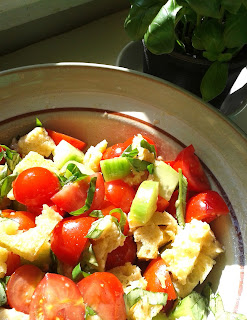A couple of weeks ago i went to Copenhagen for the weekend. Denmark is now world renowned for its food and fine dining, it also famous for being very expensive.
We had a fantastic weekend with lots of delicious food, mainly thanks to our hosts James and Tali. Their local knowledge and home cooking meant we ate very well but didn't spend a fortune.
Here are some of the foodie highlights!
First stop when i arrived in Copenhagen was the organic hot dog stand next to the Rundetarn. Delicious with lots of sauce, mustard, gherkins and 2 types of onion.


In Copenhagen there is an area called Christiania, it was set up in the 1970s when a military barracks was taken over and became a commune. It is governed by its own laws. We sat by the lake and had a couple of beers and then headed to the vegetarian restaurant. The menu is small but the food is great. I had a cheesy, beany bake thing with a noodle salad and watermelon salad.
The bakery in Valby near where we were staying had an amazing selection of bread, the Danish really know how to make rye breads and loaves packed with seeds.
For our last meal before saying goodbye, Clare and Tali opted for the famous Danish open sandwich - Smorrebrod with traditional toppings of prawn, herring and roast beef.
Thanks Tali and James for welcoming us to Copenhagen.
Rachael x
We had a fantastic weekend with lots of delicious food, mainly thanks to our hosts James and Tali. Their local knowledge and home cooking meant we ate very well but didn't spend a fortune.
Here are some of the foodie highlights!
First stop when i arrived in Copenhagen was the organic hot dog stand next to the Rundetarn. Delicious with lots of sauce, mustard, gherkins and 2 types of onion.
On our first evening in Copenhagen Tali cooked Danish meatballs (frikadeller), we had them with veg and pickled red cabbage.


In Copenhagen there is an area called Christiania, it was set up in the 1970s when a military barracks was taken over and became a commune. It is governed by its own laws. We sat by the lake and had a couple of beers and then headed to the vegetarian restaurant. The menu is small but the food is great. I had a cheesy, beany bake thing with a noodle salad and watermelon salad.
This is as close as we got to a table at Noma, one of the best restaurants in the world.
The bakery in Valby near where we were staying had an amazing selection of bread, the Danish really know how to make rye breads and loaves packed with seeds.
For our last meal before saying goodbye, Clare and Tali opted for the famous Danish open sandwich - Smorrebrod with traditional toppings of prawn, herring and roast beef.
Thanks Tali and James for welcoming us to Copenhagen.
Rachael x



























